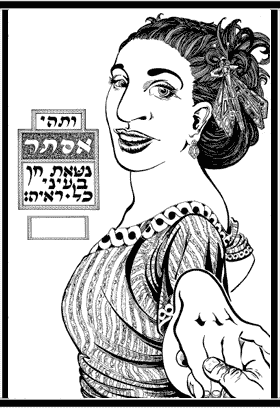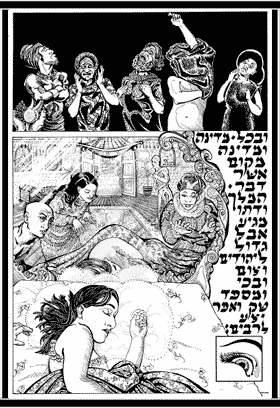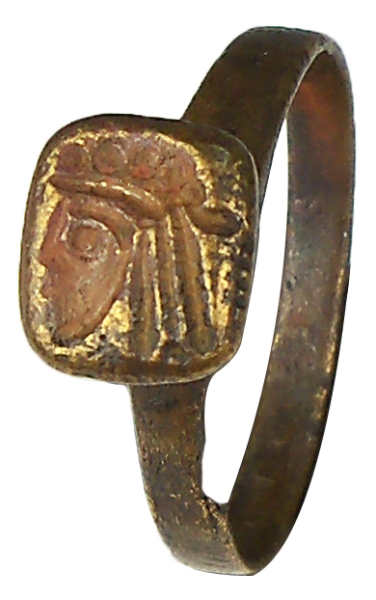Moonshine Adar | Rabbi
Mishael Zion | Text and the City | Purim 2015

It’s easy to underestimate the story of Esther. With its burlesque scenes, over-the-top characters and ancient court politics, it can seem uninspiring. Its setting in the child-friendly Purim and its violent ending make it seem juvenile, if not inappropriate. Yet the scroll of Esther is the Biblical book which comes closest to describing our current reality. I am not referring to Iranian plots against the descendants of Mordechai, but rather the attempt to navigate an absurd world, caught between the opposite poles of randomness and law, without divine guidance.
This month’s edition of
Moonshine includes two explorations of themes in the Scroll of Esther. As
always, while sharing my own thoughts about the text, this is to be read mostly
as an invitation to one’s own studying of the text. Esther’s
10 chapters are a quick and fun read - especially if you try JT Waldman’s animated version. Understanding
its structure is another good shortcut, as is focusing on chapters 1-7. Scroll
down for three questions to ask oneself (or your hevruta) as you study this
tale.
Wishing you a joyous
month of Adar, a Purim of revelry and – who knows – perhaps even a positive reversal
of fate…
Mishael
1: Dat and Data: Between
Randomness and Law
Purim is - literally - the celebration of
randomness. As the Scroll itself says: “That is why they named these days
“Purim” – from the word Pur [=lot]”. In the darkest moment of the scroll, the
date for Haman’s malicious plot to exterminate the Jews is determined by a
random lot (“pur”). At its brightest moment, the salvation too feels
random, not so much a final redemption as much as a temporary political
windfall. Indeed, the whole book, with its giddy King, comedic reversals and
lack of divine providential voice attempts to make the reader feel like they
are living in a reality governed by randomness.
 The experience of randomness
is magnified by its juxtaposition against the often overlooked theme of the
book: Law. Throughout the scroll, though, the word used to describe law is not the Hebrew mishpat or din (Hebrew for justice), but the Persian form – dat or data. The Persian word “dat” made its way into both Biblical Hebrew and European languages. Its uses in our 21st century allow a whole new reading of the story of Esther. In modern Hebrew the word “dat” means not law but religion. In English Data signifies transmittable and storable information, the modern correlate of the Persian imperial dat. More basic than knowledge or wisdom, data is the most basic element, with a promise of objectivity and constancy. Data is a building block upon which a worldview can be built. Today, the ascendant promise of Big Data attempts to turn the seeming randomness of life into immutable containable information. Yet in Shushan data has failed.
The experience of randomness
is magnified by its juxtaposition against the often overlooked theme of the
book: Law. Throughout the scroll, though, the word used to describe law is not the Hebrew mishpat or din (Hebrew for justice), but the Persian form – dat or data. The Persian word “dat” made its way into both Biblical Hebrew and European languages. Its uses in our 21st century allow a whole new reading of the story of Esther. In modern Hebrew the word “dat” means not law but religion. In English Data signifies transmittable and storable information, the modern correlate of the Persian imperial dat. More basic than knowledge or wisdom, data is the most basic element, with a promise of objectivity and constancy. Data is a building block upon which a worldview can be built. Today, the ascendant promise of Big Data attempts to turn the seeming randomness of life into immutable containable information. Yet in Shushan data has failed.
As first glance the use of “dat” is so ubiquitous that the impression is that Ahasuerus’ (Xerxes’) kingdomis a bastion of rule
and regulation. Historically the Persian empire is regarded as the earliest and most impressive
imperial bureaucracy – an efficient legal system spanning from Africa to India. But is quickly becomes clear that dat is an empty signifier. In chapter 1 we
are introduced to Ahasuerus’ counsel of wisemen who “know law and
justice” (יודעי דת ודין). The King goes through great pains to ensure that his dat is known throughout the kingdom – notice all those horsemen appearing again
and again in the story. Haman describes the Jews as “not obeying the dat
of the King”, even the virgins are seeped in a regimen of myrrh and perfumes
for six months as is the “dat of the women”. At the height of the
dramatic reversal the King himself adheres to the immutability of his own laws,
as he tells Esther and Mordechai: “A document written in the king’s name and sealed with the king’s
signet – cannot be revoked” (Esther 8:8). The rule of dat is complete –
and thus revealed in its absurdity. When even the king himself cannot change
his own laws – you know that something is horribly wrong. Like a snake biting his own tail, in Ahasuerus’ kingdom the opposite poles of law and randomness have combined into one.
Unlike Data, which seeks to be
a representation of what is real in the world, collected and analyzed to create
information suitable for making decisions,
Dat in Shushan has become an empty signifier, an
arrow pointing towards nothing at all. I would contend that this is not just a
critique of Shushan’s Laws, or Diasporic Law, but of law as an institution. The
scroll is warning us that dat (and by proxy, data) will not contain meaning
or truth in themselves. It is what one does with them that makes the difference.
The opposite poles of
sheer randomness and insipid law can easily lead one into despair, or more likely
– cynicism and passivity. Perhaps this explains Esther’s deep passivity – both during
the virginal pageant and in response to Haman’s decree. In fact, her success is
due to her malleability and passivity, a survival mechanism that shows itself
to be a powerful strategy (Esther “asked for nothing other than what Hegai
Keeper of the Women told her to take”; “Esther obeyed the word of Mordechai
just as when she was in his ward“ Esther 2:15,20). As opposed to Vashti who
tried to take her fate in her own hands – and failed, Esther is determined to
ride the wave of randomness and let the chips fall as they may. She has felt the
randomness of dat on her own body and happened to triumph. Now in the
palace she has resigned herself to passivity and cynicism, hoping that the next
stroke of randomness will also work out in her favor.
2: Who is this?
Moments of Existential Choice
 Yet it is on the backdrop
of randomness and law – that the Scroll of Esther focuses again and again on personality. More than any other book, Esther is an in-depth exploration of its characters. Even as they are all stuck between the poles of randomness and law,
each character – save Ahasueres himself – is highlighted in exercising
their agency. This focus on moments of choice, decision and determination doesn't become irrelevant when faced with randomness and law, but is described as a deep response to it (reminiscent of Viktor Frankel’s response to radical evil and
suffering). Each character's moment of choice is juxtaposed against the vapidity
of law, dat, in Shushan. Meaning is derived not from dat, but from an
existential agency enacted despite of it.
Yet it is on the backdrop
of randomness and law – that the Scroll of Esther focuses again and again on personality. More than any other book, Esther is an in-depth exploration of its characters. Even as they are all stuck between the poles of randomness and law,
each character – save Ahasueres himself – is highlighted in exercising
their agency. This focus on moments of choice, decision and determination doesn't become irrelevant when faced with randomness and law, but is described as a deep response to it (reminiscent of Viktor Frankel’s response to radical evil and
suffering). Each character's moment of choice is juxtaposed against the vapidity
of law, dat, in Shushan. Meaning is derived not from dat, but from an
existential agency enacted despite of it.
Vashti epitomizes this moment of choice by being the one
who says no. She refuses to appear in front of Ahasuerus and the men of Shushan
in the middle of their revelry. Elias Bickerman explains that this is in fact
an existential moment for Vashti. While concubines would appear at the King’s
behest at parties, a queen in the Persian empire would leave before the imbibing
began. Being asked to appear “with the royal crown on her head” forced her to
fight for who she was – a queen, not a concubine.
Mordechai makes two choices – each one more dangerous than
the next – to refuse to bow to Haman, and to practice civil disobedience –
flouting of the dat – by appearing in the Court wearing sackcloth and
ashes. Haman too seeks to know himself. Despite trying to trap the Jews
in the claws of the law, he finds himself doubting his own plan, and wants to hang
Modrechai even before the (random) date assigned for killing the Jews. This
last flirt against the randomness that he himself unleashed is the cause of his
downfall. When this last ruse is discovered by the King (Thanks Harvona!),
Haman gets hung on the stake that he himself had prepared for Mordechai. Finally
Esther – who in chapter 4 receives a sharp wake up call from Mordechai– decides
to go to the King “not according to the law”. Esther is urged and challenged by
Mordechai, but she is not described as obeying him, she is not simply replacing
one dat with another, as some readers would contend. In fact, once
Esther agrees to take on the task of convincing the King, she is the one who
dictates the terms and devises the plan, and Mordechai is the one described as
“fulfilling the command of Esther”. Choice will trump law, and will triumph.
The only one who never
seeks to know himself is the King. Ahasueres does all he can to avoid thinking independently and
existentially. He will follow the dat with blinders on and will follow advisers when
law offers no remedy. He will never overturn his own decision – for that would require an act of self-negation – which assumes the existence of a self
to begin with. The King’s lack of introspection and self-knowledge as a way to
avoid
any decision making is most evident in his hurry to get rid of the King’s
seal, the insignia of decision making, of authority and power, the ring of
responsibility. His is the most cynical response of all.
 |
| Persian royal ring |
Understanding the functional absence of King Ahaseures puts a greater claim of responsibility on the other characters, as Haman and Mordechai understand well. But it also shines a light on the absence of the other King. God's disappearance from the stage of history denies our
characters the ability to claim that they are called by an external force.
There are no prophets, no messengers of God (or of Satan), no larger authority.
There is plenty of ego, randomness and empty law. The only thing that remains
is choice.
We live in a world of
everchanging randomness and empty laws, says the Scroll of Esther. Call it
Shushan, or diaspora, or post-modernity. What remains meaningful then? Knowing
oneself and acting from that place. In our turning Purim into a celebration of
the Carnivalesque, dressing up as someone other than ourselves, getting legally
drunk while behaving OCD about hearing every word of an ancient scroll - we
name the randomness and absurdity of life and law. But we are also called to an
existential moment of facing who we really are. Caught between the harshness of
data and the randomness of history – it is our existential choices that retain
meaning.
3: Three questions for
studying Esther:
- Notice that some characters are “flat” (Ahasueres, Mordehcai) and others “round” (Haman, Esther); for some characters we are privy to their inner monologue (Haman) and/or emotions (Ahaseures), while others we never encounter their emotions or thoughts (Esther and Mordehcai). Why does the author portray the characters in such a way, and how would the story be told differently by changing these characterizations?
- The opening two chapters set up the rest of the story, inviting the reader into the worldview of the story. As Michael Fox writes in his commentary on Esther: “The sensuality [of the virginal pageant], like the burlesque of the opening banquet, softens the mood and puts the reader off-guard, making the coming danger all the more harsh” (pg. 36). What can thus be said about the last three chapters of the book?
- The banquets – lining up the banquets allows one to identify the inner structure of the story. What do you make of this lineup:

Dedicated to a theme in the Jewish month, Moonshine is a combination Dvar Torah and springboard for learning in the coming 30 days. Moonshine - in honor of the Hebrew month’s commitment to the lunar cycle, with a hint of distilling fine spirits off the beaten track and - perhaps - intoxication.


No comments:
Post a Comment